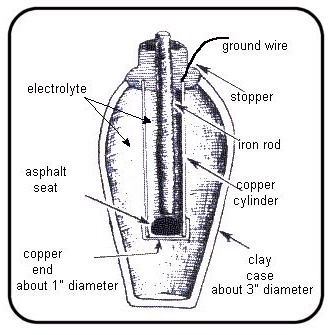Power Sources Of The Past: Are these 2,000-Year-Old Artifacts Ancient Batteries?

In 1936, during excavations on a hill in Kujut Rabua, a village southeast of Baghdad (Iraq), workers of the Iraqi State Railway Department discovered an old grave covered with a stone slab.
For two months, the Iraqi Department of Antiquities extracted a total of 613 beads, clay figurines, chiseled bricks and other pieces.
They were dated between 248 BC and 226 AD.
They also found unique terracotta pots, shaped like a vase and of a light yellowish color, containing a cylinder made of a rolled copper sheet, which houses a single iron rod. The container measured 14 cm high by 4 cm in diameter, while the copper cylinder measured 9 cm high by 2.6 cm in diameter. At the top, the iron rod is isolated from the copper by bitumen, with plugs or stoppers, and both rod and cylinder fit snugly inside the opening of the jar.
In 1939 German archaeologist Wilhelm König, then in charge of the State Museum Laboratory in Baghdad, identified the mysterious artifacts as a probable ancient electric battery.
He described his finding in 9 Jahre Iraq, published in Austria in 1940.
Respecters analyzed the alleged batters trying to prove they were really used as such. During one occasion, an electrolyte was placed inside it, connected to a lamp, which eventually turned on. The official report that was written later said that this object behaved exactly like a modern electric battery.
Once he returned to the Berlin Museum, König tried finding more similar items and found cylinders, rods and similar artifacts from Mesopotamia; all of them with thin iron and bronze rods. It seemed to him that these “batteries” could have been joined in series (one after the other) to increase the voltage for a greater power output.
If these mystery artifacts were really batteries, it would change a lot about ancient civilizations, and their capabilities and level of technology.
After World War II, Willard Gray, an electronics engineer at the High Voltage Laboratory of the General Electric Company in Pittsfield, Massachusetts, manufactured a duplicate of these batteries and filled them with copper sulfate ( although he stated that another liquid electrolyte could have been used within the reach of the inhabitants of Iraq at the time, like ordinary grape juice).
To the surprise of many, the battery operated and generated between one and two volts.
As noted by Dennielle Downs, and Ava Meyerhoff from the Smith College, “There is no written record as to the exact function of the jar, but the best guess is that it was a type of battery. Scientists believe the batteries (if that is their correct function) were used to electroplate items such as putting a layer of one metal (gold) onto the surface of another (silver), a method still practiced in Iraq today.”
Despite the fact there is evidence that the enigmatic objects could have produced electricity, the real purpose of the ‘Baghdad Batteries’ remains a mystery for many scholars.
The Discovery Channel’s series ‘Myth Busters’ built replicas of the jars to see if it was indeed possible for them to have been used for electroplating or electrostimulation in ancient times.
On MythBusters’ 29th episode (March 23, 2005), the crew behind the series produced ten hand-made terracotta jars fitted to act as batteries.
Lemon juice was chosen as the electrolyte to activate the electrochemical reaction between the copper and iron.
Connected in series, the batteries produced 4 volts of electricity.
When linked in series, the cells had sufficient power to electroplate a small token.



 Creators of mankind
Creators of mankind Description of “Tall white aliens”
Description of “Tall white aliens” Where they came from?
Where they came from? About hostile civilizations
About hostile civilizations The war for the Earth
The war for the Earth “Tall white aliens” about eternal life
“Tall white aliens” about eternal life Video: “Nordic aliens”
Video: “Nordic aliens” Aliens
Aliens Alien encounters
Alien encounters The aliens base
The aliens base UFO
UFO Technology UFO
Technology UFO Underground civilization
Underground civilization Ancient alien artifacts
Ancient alien artifacts Military and UFO
Military and UFO Mysteries and hypotheses
Mysteries and hypotheses Scientific facts
Scientific facts


















